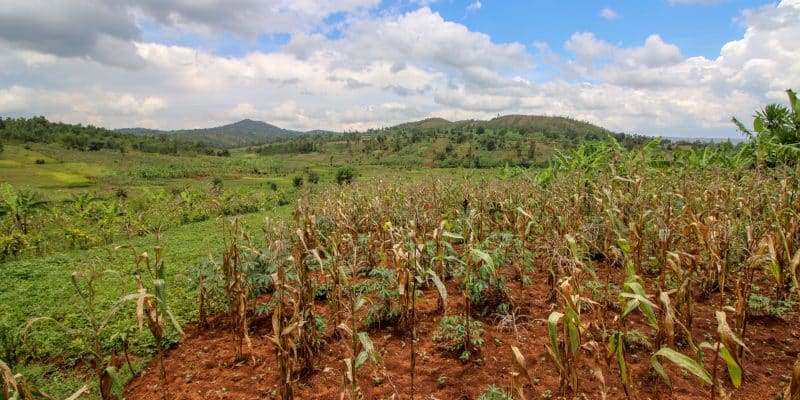Droughts and other extreme weather phenomena threaten not only human lives, but also food security. And for a continent like Africa, where farming practices are not very profitable, the bill is even higher. In the Horn of Africa, the World Food Programme (WFP) estimates that at least 20 million people are at risk of famine as a result of the drought. As an alternative, scientists are proposing a form of agriculture that is profitable, sustainable and climate-resilient.
In Africa, food security is under greater threat from extreme climatic events, particularly droughts and floods. In the absence of these phenomena, agricultural yields are already insufficient for an ever-growing population (2.1 billion inhabitants by 2050, according to the United Nations), but these yields are even lower in this context marked by climate change. According to the World Food Programme (WFP), at least 20 million people in the Horn of Africa have been at risk of famine since last year, due to the worsening drought in Kenya, Somalia and Ethiopia.
Addressing the issue of food security requires first and foremost an analysis of agricultural production. It remains one of the key variables, affecting even the average per capita food intake. According to the United Nations Food and Agriculture Organisation (FAO), between 1960 and 2000, per capita food production increased worldwide, except in sub-Saharan Africa. Although the continent has 12% of the world’s arable land, its share of world trade in agricultural products has declined from 10% in 1960 to 2% today. Its agricultural trade balance, which was balanced until 1980, has deteriorated as a result of food imports (rice, oil, wheat).
According to the FAO, food crop yields in sub-Saharan Africa are low, particularly due to a lack of organic and mineral inputs. Only around 10 kg of fertiliser per hectare per year, 20 times less than in industrialised countries and 10 times less than the world average. The same applies to the planting of trees to recycle mineral elements and fix nitrogen from the air, the creation of hill reservoirs, the irrigation of plantations and the reduction of storage losses.
The additional impact of climate
Food security is further compromised in Africa when the consequences of unprofitable agriculture are added to those of extreme weather events.
Droughts, floods, rising sea levels and hurricanes have a negative impact on people’s livelihoods. This is because these phenomena destroy crops, livestock, fish stocks, ecosystems and the infrastructure that underpins agriculture, livestock farming and fishing, not to mention production facilities such as irrigation systems and livestock shelters. This phenomenon is more acute in Africa, where climate disaster warning systems are inadequate. The “State of the Climate in Africa 2021” report published by the World Meteorological Organisation (WMO) indicates that 60% of Africa’s population is not covered by early warning systems for extreme weather events and climate change.
The African Development Bank (AfDB) points out that over 90% of African agriculture depends on rainfall. This makes it the economic sector that is most vulnerable and most exposed to the impacts of climate change. The AfDB’s forecasts are even more worrying. According to the financial institution, extreme weather events such as droughts, floods, heat stress and tropical cyclones are set to intensify and multiply. In some cases, today’s climate extremes could be tomorrow’s “normal” weather. Rising sea levels will also threaten Africa’s large coastal population. These impacts will not only jeopardise people’s well-being and livelihoods, they will also damage the environment and the economy.
More than half of the people living in poverty are small-scale farmers. According to the AfDB, they provide 80% of the food consumed in the region. Climate change, which is affecting hundreds of thousands of African farmers, is undermining local economies and exacerbating food insecurity.
It is therefore clear to African farmers, livestock breeders and fishermen that adapting to climate change means ensuring food security.
Going beyond climate-resilient agriculture
Ensuring food security in Africa in the context of climate change should take into account the parameters of productivity, sustainability and adaptation to climate change. The FAO believes that a large part of the solution lies in the various sectors that make up agriculture, in particular forestry, fisheries and aquaculture. “We have a duty to raise awareness of food security and strengthen political commitment at all levels; to develop a data analysis of the impacts and opportunities for the different agricultural sectors and make it available to policy-makers and small-scale farmers alike; to strengthen investment, research and development to build resilience and cope with the anticipated impacts of climate change”, explains the FAO.
The report by the Intergovernmental Panel on Climate Change (IPCC) calls for a model of “adaptation through transformation” that “modifies the fundamental attributes of a system in response to climate and its impacts”. Nevertheless, it should be noted that there are isolated cases in Africa today of countries that recognise the benefits of sustainable land use and profitable, climate-resilient agriculture. This is the case in Ethiopia, Kenya and Rwanda, which have already put plans in place.
Read also-AFRICA: Climate commitments from the 6th African Union-European Union Summit
In Ethiopia, the government has set up the Green and Climate Resilient Economy Strategy. The programme aims to help the country achieve middle-income status by 2025 while developing a green economy. Its four pillars are improving crop and livestock production practices; protecting and replanting forests; increasing renewable energy generation; and moving directly to energy-efficient technologies for transport, industry and construction.
Kenya’s low-carbon climate resilience plan is integrated into the national development plan, Kenya Vision 2030. The East African country has replaced traditional GDP-based development models with a new model that incorporates the social dimensions of development progress. Kenyan smallholder farmers are encouraged to adopt climate-resilient farming systems such as agroforestry, no-till farming and crop diversification to ensure food security.
Rwanda’s climate-resilient green agriculture approach is part of a comprehensive approach that combines sustainable wealth creation and poverty reduction, through sustainable natural resource management and climate-resilient and green economic growth. This involves reducing poverty by empowering the rural poor, both men and women, to participate in the transformation of the agricultural sector and in rural development, and by reducing their vulnerability to climate change. Rwanda has pledged to devote 10% of its budget to agriculture, to ensure that the sector grows by 6%.
In East and West Africa, where food security is an acute issue, experts are advising rural communities to adopt mixed and terraced farming. “This involves diversifying crops (maize, vegetables, etc.), improving irrigation and facilitating access to seeds and species that are more resistant to climate change”, explains Tamer El-Raghy, of the venture capital fund ARAF (Acumen Resilient Agriculture Fund), which operates in several African countries affected by climate change.
Boris Ngounou





